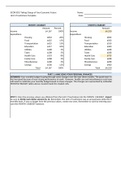Other
Touchstone Analyzing Your Personal Finances
- Institution
- Strayer University
Touchstone:Analyzing Your Personal Finances SCENARIO: Three months have passed since you created your first financial plan (i.e., the Unit 2 Touchstone). In that time, your budget has gone through some changes. The good news is that your income has increased because of your strong performance at w...
[Show more]



